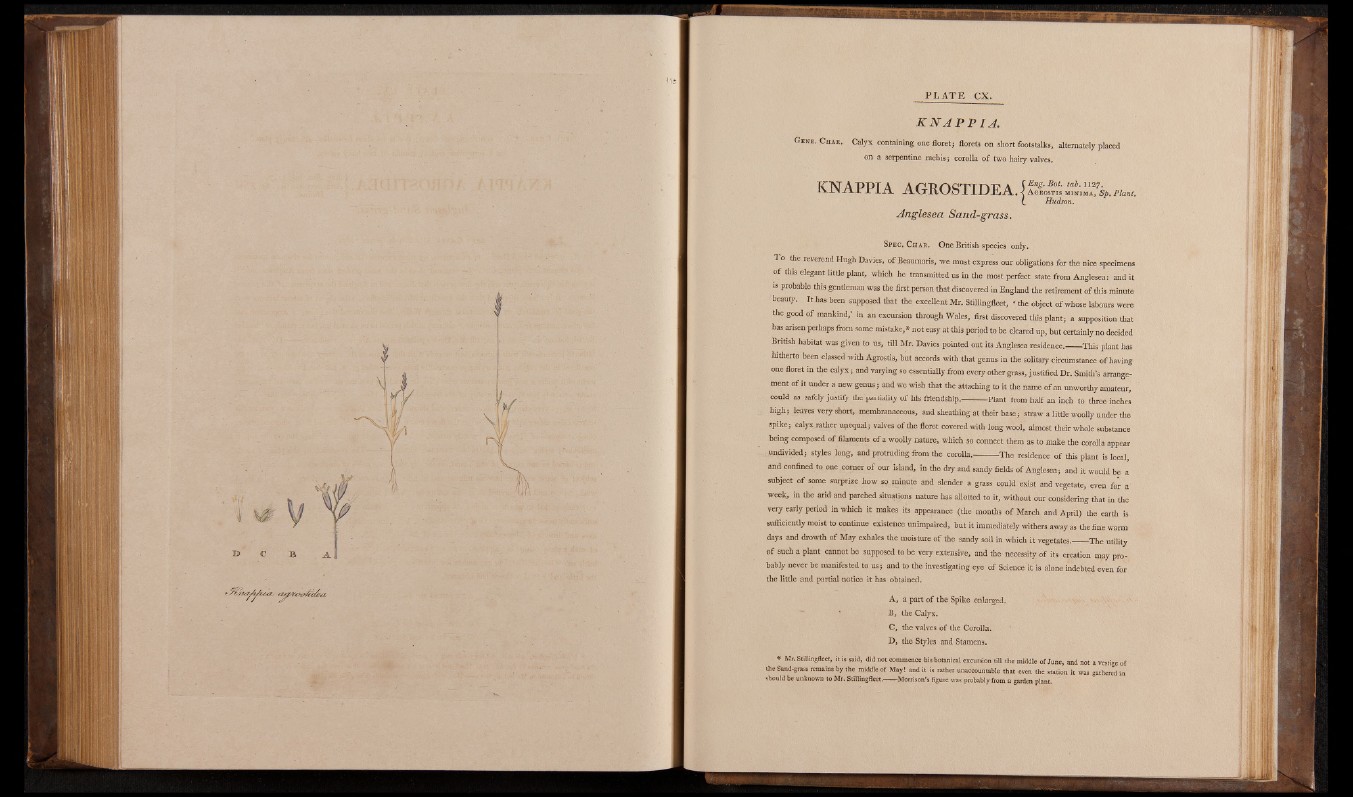
K N A P P I A.
Gbne. Chau, Calyx containing one floret; florets on short footstalks, alternately placed
on a serpentine rachisj corolla o f two hairy valves.
KNAPPIA AGROSTIDEA.j Agrostis minima, Sp. Plant.
(_ Hudson.
Anglesea Sand-grass.
Spec, C h a r . One British species only.
1 o the reverend Hugh Davies, of Beaumaris, we must express our obligations for the nice specimens
o f this elegant little plant, which he transmitted us in the most perfect state from Anglesea: and it
is probable this gentleman was the first person that discovered in England the retirement of this minute
beauty. It has been supposed that the excellent Mr. Stillingfleet, ‘ the object of whose labours were
the good o f mankind,’ in an excursion through Wales, first discovered this plant; a supposition that
has arisen perhaps tom some mistake,* not easy at this period to be cleared up, but certainly no decided
British habitat was given to us, till Mr. Davies pointed out its Anglesea residence.------This plant has
hitherto been classed with Agrostis, but accords with that genus in the solitary circumstance of having
one floret in the calyx; and varying so essentiaUy from every other grass, justified Dr. Smith's arrangement
of it under a new genus; and we wish that the attaching to it the name of an unworthy amateur,
could as safely justify the partiality of his friendship.--------- Plant from half an inch to three inches
high; leaves very short, membranaceous, and sheathing at their base; straw a little woolly under the
spike; calyx rather unequal; valves of the floret covered with long wool, almost their whole substance
being composed of filaments of a woolly nature, which so connect them as to make the corolla appear
undivided; styles long, and protruding from the corolla.--------- The residence o f this plant is local,
and confined to one corner of our island, in the dry and sandy fields of Anglesea; and it would be a
subject of some surprize how so minute and slender a grass could exist and vegetate, even for a
week, in the arid and parched situations nature has allotted to it, without our considering that in the
very early period in which it makes its appearance (the months of March and April) the earth is
sufficiently moist to continue existence unimpaired, but it immediately withers away as the fine warm
days and drowth of May exhales the moisture of the sandy soil in which it vegetates.____The utility
o f such a plant cannot be supposed to be very extensive, and the necessity of its creation nray probably
never be manifested to us; and to the investigating eye of Science it is alone indebted even for
the little and partial notice it has obtained.
A, a part of the Spike enlarged.
B, the Calyx.
C, the valves of the Corolla.
D, the Styles and Stamens.
* Mr. Stillingfleet, it is said, did not commence his botanical excursion till the middle of June, and not a vestige of
the Sand-grass remains by the middle of May! and it is rather unaccountable that even the station it was gathered in
should be unknown to Mr. Stillingfleet.----- Morrison’s figure was probably from a garden plant.